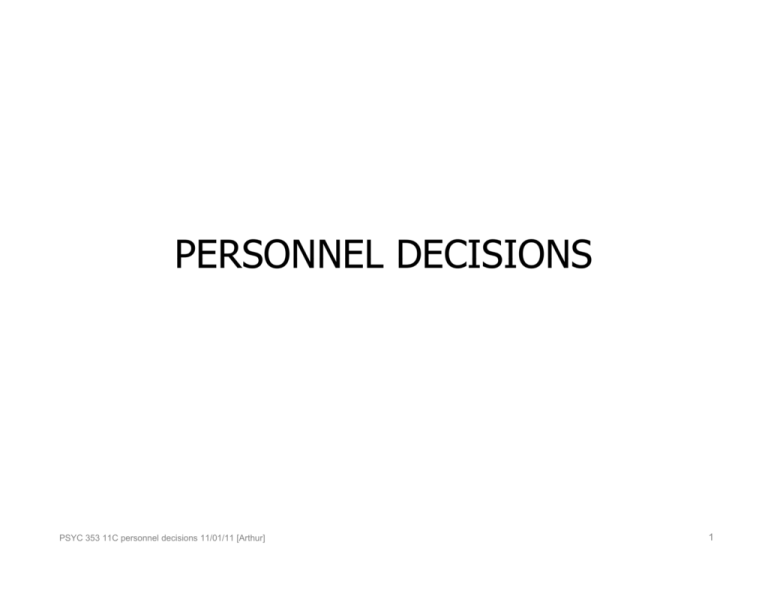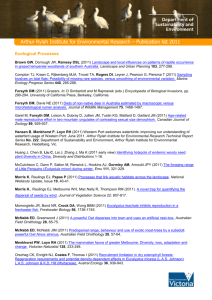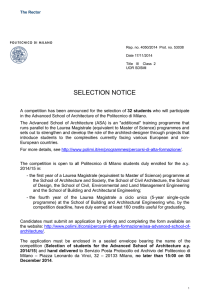personnel decisions
advertisement

PERSONNEL DECISIONS PSYC 353 11C personnel decisions 11/01/11 [Arthur] 1 Personnel Psychology – subfield of I/O psychology focusing on the management of human resources Recruitment 3 Selection Placement Psychometrics 3 Individual differences 3 Criterion development Performance appraisal PSYC 353 11C personnel decisions 11/01/11 [Arthur] Training and development Team selection and training Legal issues - Equal Emplo ment Employment Opportunity, Title VII, CRA 1991 2 Applicant/employee A li t/ l fl flow th through h and d iinteractions t ti with various PERSONNEL systems PSYC 353 11C personnel decisions 11/01/11 [Arthur] 3 • what to do with predictor or test scores now that we have them? • how do we decide who to select or hire? PSYC 353 11C personnel decisions 11/01/11 [Arthur] 4 Overview of selection process • Several stakeholders in selection p process – I/O psychologists – HR professionals – applicants – legal system (potentially) PSYC 353 11C personnel decisions 11/01/11 [Arthur] 5 Overview of selection process • I/O Psychologists – determine KSAOs needed • job analysis – develop assessment tools • validation studies • recommend d cutoff t ff scores – aware of . . . • legal context • applicant reactions PSYC 353 11C personnel decisions 11/01/11 [Arthur] 6 Overview of selection process • HR Professionals – application of assessment tools a personnel p o selection o decisions d o – make • social context – organizational image/culture – nepotism • may deviate from recommendations and best practices PSYC 353 11C personnel decisions 11/01/11 [Arthur] 7 Overview of selection process • Applicants – concerned with fairness and outcomes • face validity • procedural justice • Legal system – enforces Title VII, CRA, ADA/ADAA, ADEA PSYC 353 11C personnel decisions 11/01/11 [Arthur] 8 Selection decisions Job analysis y Development of predictors Validate [& set cutoff] Examine results Assess utility PSYC 353 11C personnel decisions 11/01/11 [Arthur] 9 Development of predictors • Determine the KSAOs to be assessed and method of assessment • Conduct validation study – content-related content related validation study • focus on extent to which test samples or represents the domain of interest – criterion-related validation study • focus on empirical p relationship p between predictor and criterion – requires incumbent predictor and criterion data – construct-related t t l t d validation lid ti study t d PSYC 353 11C personnel decisions 11/01/11 [Arthur] 10 Multiple regression • one predictor – Y = a + bX Y = predicted criterion score a = intercept; a constant b = slope; weight associated with the predictor score based on the correlation with the criterion – example a = 50; b = .50 Y = 50 + .50 (X) PSYC 353 11C personnel decisions 11/01/11 [Arthur] 11 Multiple regression Y = job performance X1 = programming skills PSYC 353 11C personnel decisions 11/01/11 [Arthur] 12 Multiple regression Y = job performance X1 = cognitive ability PSYC 353 11C personnel decisions 11/01/11 [Arthur] X2 = agreeableness 13 Multiple regression • Y = a + b1X1 + b2X2 + . . . bnXn • use multiple predictors in test battery to account for more variance • p predictors that correlate with criterion but NOT with each other • incremental validityy PSYC 353 11C personnel decisions 11/01/11 [Arthur] 14 Multiple regression Example of Hypothetical Predictor/Criterion Correlation Matrix Measure Mean SD 1. 2. 3. 4. 5. 6. 1. Verbal Ability 43.57 9.84 .85 2. Math Ability 22.36 4.98 .22* .89 3. GMA 65.93 11.97 .91* .60* 5.36 0.79 .31* .33* .39* .91 37.20 6.88 -.02 .06 .01 .02 .77 8.27 1.20 .08 .02 .07 .17* .09* .87 17.48 3.16 .12* .16* .17* .08 .22* -.01 4 91 4.91 0 98 0.98 .10 10* .14 14* .14 14* .25 25* .21 21* 4. Conscientiousness 5. Extraversion 6. Interpersonal skills 7. Leadership 8 Performance 8. PSYC 353 11C personnel decisions 11/01/11 [Arthur] 7. 8. .91 .15 15* .86 .32 32* .88 88 15 Cross-validation • Because of changes due to time, people, situations, and criteria, it is essential to make an independent check on the validity of measures used for predictive purposes. empirical p – derivation sample – cross-validation sample statistical estimation PSYC 353 11C personnel decisions 11/01/11 [Arthur] 16 Cutoff scores • Type of cutoff score depends on . . . – validation study type • content- versus criterion-related validation study – frame-of-reference • norm-referenced norm referenced – cutoff score is dependent on sample • criterion-referenced – cutoff score is independent of sample PSYC 353 11C personnel decisions 11/01/11 [Arthur] 17 Cutoff scores Classification of Major Cutoff Score Methods PSYC 353 11C personnel decisions 11/01/11 [Arthur] 18 Cutoff scores • norm-referenced norm referenced mean standard deviation percentile base-rate • criterion-referenced regression [ X = (Y – a) ÷ b ] 70% Angoff procedure PSYC 353 11C personnel decisions 11/01/11 [Arthur] 19 Cutoff scores • Base rate: proportion of employees who are successfullyy p performing g the job • Regression: X = (Y – a) ÷ b • Angoff: g average g item probability p y that a minimallyy competent p person would answer the item correctly PSYC 353 11C personnel decisions 11/01/11 [Arthur] 20 Cutoff scores • banding ag group p of scores are considered equivalent q and not differentiated between when making a selection decision based on the premise that reliability of test scores is NOT p perfect calculated from the standard error of measurement (which is based on the reliability of the test scores) can be fixed or sliding PSYC 353 11C personnel decisions 11/01/11 [Arthur] 21 Cutoff scores • once cutoff scores have been set, then what? rank and select top down random any others? th ? PSYC 353 11C personnel decisions 11/01/11 [Arthur] 22 Selection decision outcomes Selection Decisions Decisions, Outcomes Outcomes, and Some Factors That Influence Them PSYC 353 11C personnel decisions 11/01/11 [Arthur] 23 Selection decisions • classification outcomes A = true positives B = true negatives g C = false negatives D = false positives • costs associated with classification errors? PSYC 353 11C personnel decisions 11/01/11 [Arthur] 24 Selection decisions • classification decisions are influenced y by: selection ratio (# openings ÷ # applicants) cutoff score (predictor) base rate (criterion “cutoff”) test validity PSYC 353 11C personnel decisions 11/01/11 [Arthur] 25 Selection decisions – predictor cutoff Selection Decisions Decisions, Outcomes Outcomes, and Some Factors That Influence Them PSYC 353 11C personnel decisions 11/01/11 [Arthur] 26 Selection decisions – predictor cutoff P1 PSYC 353 11C personnel decisions 11/01/11 [Arthur] 27 Selection decisions – predictor cutoff P2 PSYC 353 11C personnel decisions 11/01/11 [Arthur] 28 Selection decisions – base rate C1 PSYC 353 11C personnel decisions 11/01/11 [Arthur] 29 Selection decisions – base rate C2 PSYC 353 11C personnel decisions 11/01/11 [Arthur] 30 Selection decisions – test validity Job performanc ce 10 75 7.5 25 2.5 0 60 65 70 75 Cognitive ability PSYC 353 11C personnel decisions 11/01/11 [Arthur] 31 Selection decisions – test validity PSYC 353 11C personnel decisions 11/01/11 [Arthur] 32 Selection decisions – test validity PSYC 353 11C personnel decisions 11/01/11 [Arthur] 33 Selection decisions – test validity PSYC 353 11C personnel decisions 11/01/11 [Arthur] 34 Selection decisions – test validity PSYC 353 11C personnel decisions 11/01/11 [Arthur] 35 Selection decisions Strategies for Making Selection Decisions • multiple regression approach • multiple cutoff approach • multiple lti l hurdle h dl approach h • characteristics? PSYC 353 11C personnel decisions 11/01/11 [Arthur] 36 Utility Analysis • value of personnel decisions to the organization • determined by: validity lidit off the th predictor di t cost to administer the predictor # of people who do the job # of people hired each year typical tenure in the job PSYC 353 11C personnel decisions 11/01/11 [Arthur] 37 Utility analysis ∆U = (NS × T × SDy × rxy × Zx) – (NA × C) • ∆U = increase in average dollar-valued payoff resulting from use of selection procedure over random selection • T = expected tenure of selected group • rxy = correlation between selection procedure scores and criterion scores (validity of test) • SDy = standard deviation of dollar-valued job performance • Zx = average g standard p predictor score of selected g group p • NS = number of applicants selected • NA = number of applicants tested • C = costt off testing t ti one applicant li t PSYC 353 11C personnel decisions 11/01/11 [Arthur] 38 Utility analysis • High Performance Work Systems selective staffing comprehensive training developmental performance appraisal equitable reward systems performance based pay performance-based PSYC 353 11C personnel decisions 11/01/11 [Arthur] 39 Legal issues Legal Issues 1964 Civil Rights g Act (Title ( VII)) and CRA 1991 • cannot make employment-related decisions on basis of protected class status/variable • protected classes ¨ race, race sex sex, religion religion, color, color and national origin • “employment-related decisions” covers all personnel decisions such as selection selection, training, training promotion, promotion retention, retention and performance appraisal PSYC 353 11C personnel decisions 11/01/11 [Arthur] 40 Legal issues • CRA 1991 explicitly prohibits test score adjustments • Equal Employment Opportunity Commission (EEOC) PSYC 353 11C personnel decisions 11/01/11 [Arthur] 41 Legal issues Theories of discrimination • disparate p treatment • disparate impact (adverse impact) 4/5th or 80% rule significance tests PSYC 353 11C personnel decisions 11/01/11 [Arthur] 42 Legal issues — disparate impact • 80% rule S Sex Male Female Apply 100 200 Hire 20 180 20% 90% Selection rate • adverse d iimpactt = 20 ÷ 90 = 22% • < 80% so have adverse impact PSYC 353 11C personnel decisions 11/01/11 [Arthur] 43 Legal issues — disparate impact Legal defenses to adverse impact • jjob-relatedness ((i.e.,, validity) y) • bona fide occupational qualification (BFOQ) • business necessity PSYC 353 11C personnel decisions 11/01/11 [Arthur] 44 Legal issues Major Court Cases • Griggs v. v Duke Power Company (1971) – burden of proof on defendant not plaintiff • Albemarle Paper Company v. Moody (1975) – job analysis • Bakke v. University of California (1978) – “reverse” discrimination • Watson vv. Fort Worth Bank & Trust (1988) – what is a “test” ¨ interviews – cost of alternative predictors can be a consideration • Wards Cove Packing Company vv. Antonio (1989) – modified burden of proof guidelines; served as impetus for CRA 1991 PSYC 353 11C personnel decisions 11/01/11 [Arthur] 45 Legal issues 1967 Age Discrimination in Employment Act (ADEA) • employees 40 yrs of age and older • prevent older employees from being singled out during cutbacks • 1990 Older Workers Benefit Protection Act PSYC 353 11C personnel decisions 11/01/11 [Arthur] 46 Legal issues 1990 Americans A i with ith Disabilities Di biliti Act A t (ADA; (ADA ADAAA) • 43 million Americans have a disability • disability ¨ physical or mental impairment that limits one or more “major life activity” • prohibits discriminating against “qualified individuals” (can perform “essential” functions) • provide reasonable accommodations • employers with 15 or more employees • up to $300,000 in compensatory & punitive damages PSYC 353 11C personnel decisions 11/01/11 [Arthur] 47 Legal issues Affirmative Action • NOT a p psychometric y issue • social policy aimed at reducing the effects of prior discrimination • although EEOC guidelines stipulate that only govt employers and govt contractors must have written affirmative action policies, many private sector employers do so as well believe it makes good business sense • 3 Goals correct past inequities compensate past inequities [court ordered and supervised] promote diversity • NOT quotas PSYC 353 11C personnel decisions 11/01/11 [Arthur] 48 Legal issues Types or levels of affirmative action • • • • • recruitment removing discriminatory obstacles soft preferential treatment h d preferential hard f i l treatment (illegal) (ill l) diversity [targeted recruitment] PSYC 353 11C personnel decisions 11/01/11 [Arthur] 49


